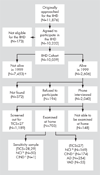Relationship between body height and dementia
- PMID: 15703320
- PMCID: PMC3163094
- DOI: 10.1176/appi.ajgp.13.2.116
Relationship between body height and dementia
Abstract
Objective: Structural and functional brain reserves, thought to develop in childhood and adolescence, may be critical in determining the age at onset of cognitive impairment. Body height is affected by childhood conditions that promote growth. The authors examine the relationship of height in midlife and subsequent dementia, Alzheimer disease (AD), and vascular dementia.
Methods: Dementia was evaluated from 1999 to 2001 in 1,892 men age 76 to 95. Height had been measured when these men participated in the Israeli Ischemic Heart Disease project in 1963. Age, socioeconomic status (SES), and area of birth were also assessed in 1963.
Results: Older men and those with lower SES tended to be shorter. Relative to the shortest quartile, controlling for age, SES, and area of birth, the other quartiles had lesser respective odds ratios for dementia as a whole, AD, and vascular dementia.
Conclusion: Height was inversely associated with dementia, AD, and vascular dementia in a male sample. Since height is associated with childhood nutrition and may be associated with other risk factors for dementia, efforts to improve early life conditions that maximize body growth may diminish or delay the onset of dementia in later life.
Figures

Similar articles
-
Height as a marker of childhood development and late-life cognitive function: the Honolulu-Asia Aging Study.Pediatrics. 1998 Sep;102(3 Pt 1):602-9. doi: 10.1542/peds.102.3.602. Pediatrics. 1998. PMID: 9738183
-
Body mass index in midlife and risk of Alzheimer disease and vascular dementia.Curr Alzheimer Res. 2007 Apr;4(2):103-9. doi: 10.2174/156720507780362047. Curr Alzheimer Res. 2007. PMID: 17430231
-
Association of Demographic and Early-Life Socioeconomic Factors by Birth Cohort With Dementia Incidence Among US Adults Born Between 1893 and 1949.JAMA Netw Open. 2020 Jul 1;3(7):e2011094. doi: 10.1001/jamanetworkopen.2020.11094. JAMA Netw Open. 2020. PMID: 32716513 Free PMC article.
-
Early Life Epidemiology of Alzheimer's Disease--A Critical Review.Neuroepidemiology. 2015;45(4):237-54. doi: 10.1159/000439568. Epub 2015 Oct 27. Neuroepidemiology. 2015. PMID: 26501691 Free PMC article. Review.
-
Evidence of Impact of Interventions on Growth and Development during Early and Middle Childhood.In: Bundy DAP, Silva ND, Horton S, Jamison DT, Patton GC, editors. Child and Adolescent Health and Development. 3rd edition. Washington (DC): The International Bank for Reconstruction and Development / The World Bank; 2017 Nov 20. Chapter 7. In: Bundy DAP, Silva ND, Horton S, Jamison DT, Patton GC, editors. Child and Adolescent Health and Development. 3rd edition. Washington (DC): The International Bank for Reconstruction and Development / The World Bank; 2017 Nov 20. Chapter 7. PMID: 30212122 Free Books & Documents. Review.
Cited by
-
The Relationship between Height and Cognitive Function among Community-dwelling Elderly: Hallym Aging Study.Epidemiol Health. 2013 Apr 30;35:e2013002. doi: 10.4178/epih/e2013002. Print 2013. Epidemiol Health. 2013. PMID: 23682335 Free PMC article.
-
Body adiposity in late life and risk of dementia or cognitive impairment in a longitudinal community-based study.J Gerontol A Biol Sci Med Sci. 2009 Jan;64(1):103-9. doi: 10.1093/gerona/gln006. Epub 2009 Jan 23. J Gerontol A Biol Sci Med Sci. 2009. PMID: 19168781 Free PMC article.
-
Shorter adult height is associated with poorer cognitive performance in elderly men with type II diabetes.J Alzheimers Dis. 2015;44(3):927-35. doi: 10.3233/JAD-142049. J Alzheimers Dis. 2015. PMID: 25374105 Free PMC article.
-
Growth hormone and aging: a challenging controversy.Clin Interv Aging. 2008;3(4):659-65. doi: 10.2147/cia.s3697. Clin Interv Aging. 2008. PMID: 19281058 Free PMC article. Review.
-
Religious education and midlife observance are associated with dementia three decades later in Israeli men.J Clin Epidemiol. 2008 Nov;61(11):1161-8. doi: 10.1016/j.jclinepi.2007.09.011. Epub 2008 Jun 6. J Clin Epidemiol. 2008. PMID: 18538995 Free PMC article.
References
-
- Stern Y, Gurland B, Tatemichi T. Influence of education and occupation on the incidence of Alzheimer’s disease. Neurology. 1993;43:839–844. - PubMed
-
- Snowdon DA, Greiner LH, Markesbery WR. Linguistic ability in early life and the neuropathology of Alzheimer’us disease and cerebrovascular disease. Findings from The Nun Study. Ann N Y Acad Sci. 2000;903:34–38. - PubMed
-
- Graves AB, Mortimer JA, Larson EB, et al. Head circumference as a measure of cognitive reserve: association with severity of impairment in Alzheimer’s disease. Br J Psychiatry. 1996;169:86–92. - PubMed
-
- Schofield PW, Mosesson RE, Stern Y, et al. The age at onset of Alzheimer’s disease and an intracranial area measurement. Arch Neurol. 1995;52:95–98. - PubMed
-
- Barker JD. The malnourished baby and infant. Br Med Bull. 2001;60:69–88. - PubMed
Publication types
MeSH terms
Grants and funding
LinkOut - more resources
Full Text Sources
Medical

